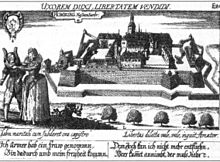Hans Sommer (Wasserbauer)
Hans Sommer (* in the 16th century ; † in the 16th or 17th century ) was a German hydraulic engineer from Kempten who specialized in water hoists.
The Homburg Water Art
In 1571 he received the order from Count Johann IV of Nassau-Saarbrücken , who had taken over the Homburg on the Schlossberg in 1544 , to construct a "water art" with the help of which the water should be transported from a well in the Erbachtal into the castle. The difference in altitude was about 100 meters. With the exception of the lead lines, which were cast in Homburg, Sommer designed and manufactured the technical systems in his own workshop and then transported them to Strasbourg, where the count had them picked up. Two piston rods were driven by a crankshaft and pulled the water into a suction pipe. From there it was fed into a cylinder and finally into a pressure pipe. Sommer's water art was completed in the spring of 1575; his client died earlier. The system was probably in operation until it was destroyed in the course of the French Revolution and saved the castle residents the use of cisterns or the uncomfortable transport of water with donkeys, which had been carried out before the lift was installed.
The Rothenburg water art
In 1593, Hans Sommer and his son were commissioned to construct the “ Rothenburg New Water Art” at the Bronnenmühle . The Bronnenmühle is now a listed mill ensemble, which consists of a water hoist, a grain mill and a sawmill and is now used for gastronomic purposes, but was only under construction in the summer. The mill itself was built from 1595 to 1600; Hans Sommer and his son built the water lift, which was driven by an 8-meter mill wheel, between 1593 and 1595. The spring water from the Taubergrund was pressed through a lead pipe into the elevated tank in the blade tower by means of four pump cylinders. It covered a distance of about 350 meters and a difference in altitude of 80 meters. Eight municipal wells in Rothenburg were supplied with water from the elevated tank via a two-line pipe system. The "Rothenburger Neue Wasserkunst" is likely to have been unique in southern Germany with its level of funding at the time. Their pumps worked until 1853, then they were replaced by a turbine , which today is likely to be one of the oldest in Franconia . Around 1950 the pumping operation in the Bronnenmühle was terminated and the supply of the Rothenburg fountain was switched to long-distance water.
Individual evidence
- ↑ Ernst Joachim: Johann IV of Nassau-Saarbrücken . In: Allgemeine Deutsche Biographie (ADB). Volume 14, Duncker & Humblot, Leipzig 1881, p. 264 f.
- ^ Hans-Henning Krämer: From the village well to the waterworks. History of the drinking water supply on the Saar (= Saarland Library. Vol. 13). Gollenstein, Blieskastel 1999, ISBN 3-933389-07-0 , p. 21 ff.
- ↑ Bronnenmühle
| personal data | |
|---|---|
| SURNAME | Summer, Hans |
| BRIEF DESCRIPTION | Hydraulics specialist |
| DATE OF BIRTH | 16th Century |
| DATE OF DEATH | 16th century or 17th century |
